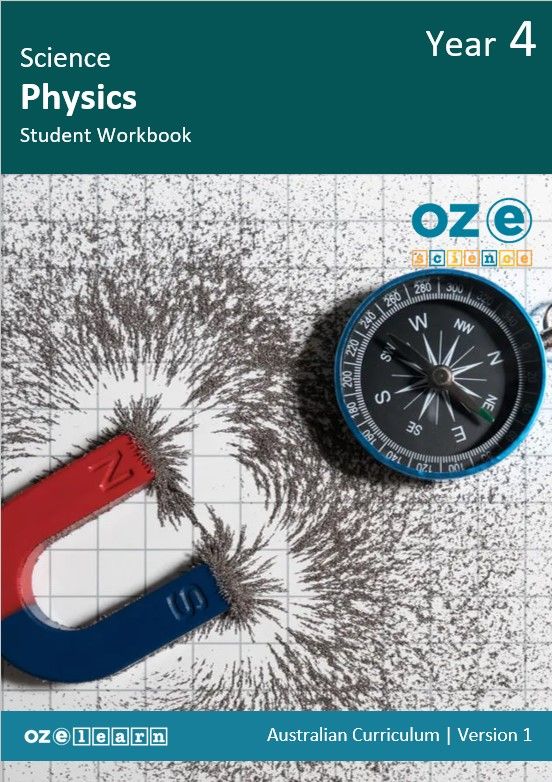Oz-e-science
Physics - Year 4
Write your awesome label here.
Write your awesome label here.

Teaching resources
Overview
Physics Year 4 is the study of what things are made of, how they move, and how they get energy. It aligns to the Australian Curriculum Science Understanding:
Note: This curriculum program is currently being updated to align with the Australian Curriculum 9.0. Updated versions will be released in early 2024.
- Forces can be exerted by one object on another through direct contact or from a distance (ACSSU076).
Note: This curriculum program is currently being updated to align with the Australian Curriculum 9.0. Updated versions will be released in early 2024.
Learning Objectives
In lessons 1 to 9, students learn about:
- what a force is and identify some common examples of forces in our everyday lives
- identifying different types of forces and explain the difference between contact and noncontact forces
- describing the ways forces can push and pull objects, causing them to move or stop moving.
- how forces can resist objects when they are moving
- how forces can repel two objects away from each other or attract two objects closer to each other.
- the force of gravity and how it affects objects of different sizes and shapes
- Sir Isaac Newton and how his law of forces can explain the size and direction of forces
- the Scientific Method to investigate Newton’s Laws
- preparing a report about our findings.
Success Criteria
- Describe what a force is.
- Identify some common examples of forces.
- Explain what happens to an object when a force acts on it.
- Identify contact and non-contact forces.
- Explain what happens to objects when contact and non-contact forces act on them.
- Identify the forces used in pushing and pulling objects.
- Explain what normal and applied forces are.
- Investigate motion by experimenting with pushing and pulling objects.
- Identify the forces that can resist an object’s movement.
- Explain what friction and resistance are.
- Investigate friction by experimenting with objects moving.
- Identify the forces that can attract and repel objects.
- Explain what magnetic fields are.
- Investigate attracting and repelling by experimenting with magnets.
- Explain what gravity is.
- Describe how gravity works.
- Investigate gravity by experimenting with objects falling.
- Describe Newton’s Laws.
- Compare the size and direction of forces.
- Investigate what happens to an object experiencing more than one force.
- Identify the steps in the Scientific Method.
- Experiment with Newton’s laws using cars on a ramp.
- Measure the effect that steepness of a ramp has on forces.
Assessment
Progress Tests
Progress tests are conducted after every second lesson, allowing teachers to monitor student understanding of the concepts taught over the past two lessons and to identify where reteaching is needed. The Teaching Guide contains the testing questions, and the Student Workbook has a section where students write their answers and score themselves.
Structured Research Activity
The Structured Research Activity (SRA) for this unit is: Students to investigate Newton’s laws school experiment. The SRA takes place over two lessons so students can apply the Science Understanding and Science Inquiry Skills covered in the unit. Teachers use the Guide to Making Judgements, which is included in the Teaching Guide, to mark the SRA.
End-of-unit assessment
The last lesson is the end-of-unit assessment which has a variety of question formats (e.g. label the diagram, circle the correct answer) to assess student mastery of content from the unit.
Progress tests are conducted after every second lesson, allowing teachers to monitor student understanding of the concepts taught over the past two lessons and to identify where reteaching is needed. The Teaching Guide contains the testing questions, and the Student Workbook has a section where students write their answers and score themselves.
Structured Research Activity
The Structured Research Activity (SRA) for this unit is: Students to investigate Newton’s laws school experiment. The SRA takes place over two lessons so students can apply the Science Understanding and Science Inquiry Skills covered in the unit. Teachers use the Guide to Making Judgements, which is included in the Teaching Guide, to mark the SRA.
End-of-unit assessment
The last lesson is the end-of-unit assessment which has a variety of question formats (e.g. label the diagram, circle the correct answer) to assess student mastery of content from the unit.
Recommended Units
Baninh Yeeum Building 302-310 Sheridan Street, Cairns QLD 4870
PO BOX 278, North Cairns QLD 4870
Phone: 1800 00 GGSA (4472)
info@goodtogreatschools.org.au
Empty space, drag to resize
Subscribe to our newsletter
Thank you!
Empty space, drag to resize
2023 All Rights Reserved
Write your awesome label here.
Write your awesome label here.
Write your awesome label here.
Subscribe to our newsletter now!
Get weekly updates on live streams, news and more right in your mailbox.
Thank you!
Write your awesome label here.
Write your awesome label here.
Planned 24 Hour Maintenance
Website Temporary Unavailable
10AM 05 January until 10AM 06 January 2024
Dear school teams
You will not be able to access your content during this time. We will be busy loading all the new enhancements you asked for. We are confident you will be delighted with the new features we have designed for you! Please join on Saturday after 10:00am to try them out!
School Partnerships Team

